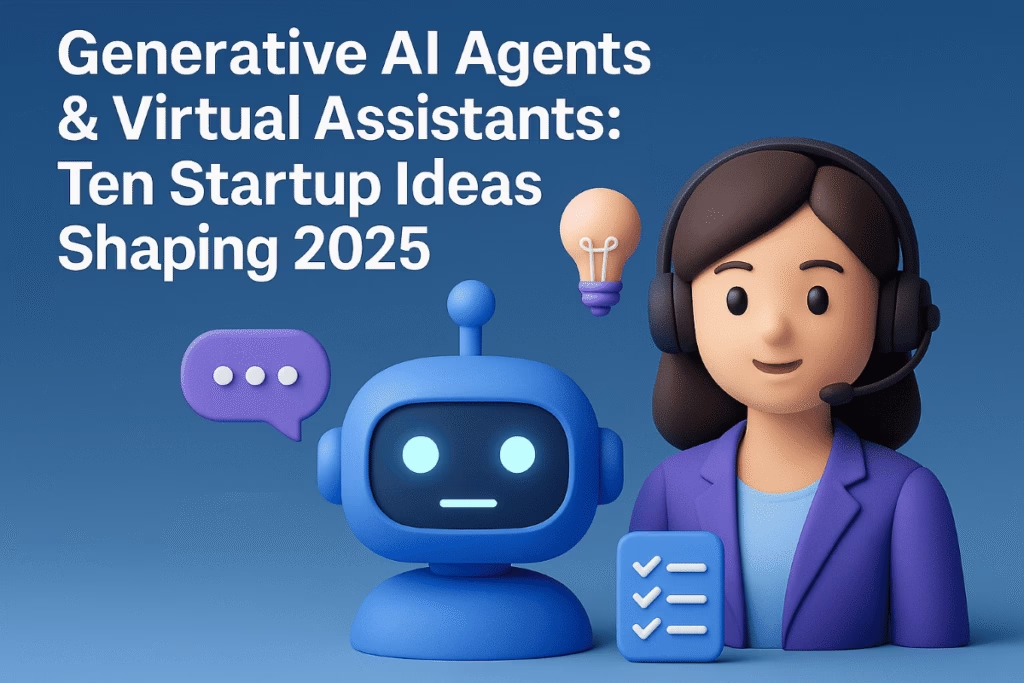For more than a decade, the SaaS playbook was simple: go broad, scale fast, and capture as many industries as possible. The goal was horizontal dominance — build one powerful platform that every business could use, from startups to enterprises.
But 2025 looks very different. The next wave of SaaS winners aren’t trying to be everything for everyone — they’re becoming irreplaceable for someone.
From healthcare to real estate to logistics, a new generation of founders is focusing on vertical SaaS: purpose-built software designed around the workflows, regulations, and nuances of a specific industry. These niche players are growing quietly but steadily, earning customer loyalty through precision rather than volume.
And the results speak for themselves — higher retention, stronger margins, and defensibility that even the biggest horizontal tools can’t easily copy.
In a world crowded with generic platforms, niche domination is the new scale.
The Evolution of SaaS — From Horizontal to Vertical
The Horizontal SaaS Era
In the early 2010s, the SaaS gold rush was defined by breadth. Tools like Salesforce, HubSpot, and Slack built massive horizontal platforms that catered to businesses of every size and sector. The idea was simple — if you could build a flexible product that solved a universal problem, the entire market was yours.
This approach worked brilliantly for a while. Companies could scale fast, raise massive rounds, and expand into countless industries with minimal adaptation. The early internet economy rewarded “go broad” thinking — scale first, specialize later.
But that model had a hidden weakness.
The Cracks in Horizontal Scale
As competition exploded, horizontal SaaS companies began to face diminishing returns. Marketing and acquisition costs skyrocketed. Differentiation eroded as new tools crowded the same categories.
Worse, generic platforms struggled to deliver deep value for specialized industries. A CRM might work fine for a tech startup, but fall short for a dental clinic, a law firm, or a construction company with field teams and compliance demands.
Customers began to demand tools that understood their language — not just their data. They didn’t want to adapt their business to a tool; they wanted a tool that already fit how they worked.
The Vertical Shift Begins
Enter vertical SaaS — products purpose-built for a single industry, with workflows, integrations, and insights deeply aligned to that market’s reality.
By 2020, vertical SaaS quietly started outperforming its horizontal counterparts in retention and growth. Platforms like Toast (restaurants), Procore (construction), and Clio (legal) didn’t chase every market — they owned their lane.
And in 2025, that lane is where the smartest SaaS founders are heading.
What Makes Vertical SaaS So Powerful
Tailored to Real-World Workflows
The biggest strength of vertical SaaS is precision. Unlike horizontal platforms that must stay generic to serve multiple industries, vertical SaaS is built around specific workflows — billing for clinics, dispatching for logistics firms, or compliance tracking for financial advisors.
This level of customization removes friction instantly. Users don’t waste time setting up complicated configurations or “hacking” workarounds. The software already feels native to how they work. That sense of familiarity translates into faster adoption and stronger trust from day one.
Lower Churn, Higher Loyalty
When your product becomes part of an industry’s daily rhythm, it’s no longer optional — it’s essential. Vertical SaaS tools often integrate deeply into core business operations, meaning switching away is painful and costly.
This operational dependency is what gives vertical SaaS its signature retention advantage. A company using Procore or Clio isn’t just replacing software; it’s changing how it does business. That’s why vertical SaaS companies often report materially lower churn rates than their horizontal peers.
Deeper Customer Empathy
One of the underrated powers of vertical SaaS is empathy. When your product, marketing, and customer success teams all speak the same industry language, trust accelerates.
Support calls feel more like consulting sessions. Marketing copy resonates with insider terms and pain points. Product updates solve real operational frustrations instead of adding “nice-to-have” features.
That emotional and professional alignment builds brand loyalty — something that broad platforms often lose in translation.
High-Margin Economics
Because vertical SaaS delivers clear, measurable value, customers are often willing to pay a premium. The logic is simple: the closer your software sits to revenue, compliance, or customer experience, the more indispensable it becomes.
Meanwhile, vertical SaaS avoids the feature bloat that burdens horizontal tools. You’re not building everything for everyone — you’re building exactly what one market needs. Fewer features, higher margins, and stronger word-of-mouth.
In short: vertical SaaS trades mass reach for deep impact — and wins on economics.
Why Niche Beats Scale in 2025
Investors Are Rewarding Focus
In 2025, focus has become a growth strategy — not a limitation. Investors and acquirers are actively favoring SaaS companies that dominate a single vertical rather than spreading themselves thin across multiple markets.
The reasoning is clear: vertical SaaS delivers predictable revenue, sticky customers, and stronger unit economics. A focused go-to-market motion means lower CAC, clearer messaging, and faster payback periods.
It’s no surprise that some of the fastest-growing SaaS IPOs and acquisitions in recent years have been vertical plays — companies that own their category with authority rather than chasing every adjacent opportunity.
AI + Vertical Data = New Moats
The rise of AI has accelerated the shift toward niche SaaS. Generic AI models can handle surface-level automation, but true differentiation now comes from vertical intelligence — models trained on domain-specific data and workflows.
A healthcare SaaS can build diagnostic insights no generic CRM can. A logistics SaaS can predict fleet performance using industry data. These specialized data loops create AI moats — competitive advantages that horizontal tools can’t easily replicate without deep domain access.
As AI becomes ubiquitous, data quality and context — not quantity — are the new edge. Vertical SaaS owns both.
Efficiency Over Expansion
In today’s tighter funding climate, the old “growth at all costs” mentality is dead. Founders are being rewarded for efficiency — strong retention, high net revenue expansion, and profitability.
Vertical SaaS naturally fits this new playbook. With a narrow ICP (ideal customer profile) and deep customer intimacy, sales cycles shorten, upsells increase, and customer success drives revenue growth instead of marketing spend.
In 2025, scaling smarter means scaling deeper. The companies that know their customer best will grow the most sustainably — even if their market looks small on paper.
Challenges Every Vertical SaaS Founder Faces
Building a vertical SaaS product may look like a focused, streamlined path — but it’s not without obstacles. The same depth that gives vertical products their defensibility also demands sharper execution, deeper research, and stronger customer intimacy.
Here are the biggest challenges founders face when building in the niche lane:
1. Smaller Addressable Market
When you build for a narrow industry, your TAM (Total Addressable Market) naturally shrinks. You can’t just pivot to a new audience overnight.
That means founders must think strategically from the start:
- How big is this vertical really?
- Is there room to expand into adjacent segments once you dominate your first?
- Can your core technology be adapted to nearby industries without breaking focus?
The smartest founders view vertical SaaS as a ladder — you climb one rung (one sub-vertical) at a time before moving up.
2. Complex Integrations and Compliance
Every industry has its own tangled ecosystem of tools, standards, and regulations. Healthcare SaaS must deal with HIPAA; financial software must manage SOC 2 and audit trails; logistics tools integrate with legacy ERPs.
These integrations and compliance requirements slow down development and raise costs — but they also build moats. Once you’ve cleared those hurdles, new entrants face the same uphill battle you did.
3. High Domain Knowledge Barriers
Selling vertical SaaS isn’t about features; it’s about understanding the customer’s business better than they do.
Your sales, marketing, and product teams need deep domain fluency — the kind you can’t fake with buzzwords. Without it, trust evaporates. That’s why many successful vertical SaaS founders come from the industries they serve — they’ve lived the pain firsthand.
4. Scaling Without Losing Focus
Ironically, the moment a vertical SaaS company succeeds, the temptation to “go horizontal” appears. Investors push for bigger markets, teams chase new use cases, and suddenly the product loses its sharp edge.
The best founders resist that urge. They expand adjacently — not randomly. For example, a legal SaaS might move from small firms to enterprise law groups before tackling compliance tech. Growth, in vertical SaaS, must be sequential, not scattershot.
Strategies for Building a Defensible Vertical SaaS
The beauty of vertical SaaS is that defensibility comes from depth — not size. When you become part of how an industry operates, competitors can’t just copy your features; they’d have to replicate your entire understanding of that market.
Here’s how to build that kind of moat.
Start Small, Dominate, Then Expand
Every successful vertical SaaS story starts narrow. Toast began with restaurant point-of-sale systems before expanding into inventory, payroll, and analytics. Clio focused on small law firms before reaching the enterprise segment.
The key is to dominate one sub-vertical first — win absolute trust, build authority, and create reference customers that speak your language. Once you’ve cemented leadership there, expand horizontally within the same vertical or to a tightly related one.
Embed AI That Understands Your Industry
Generic AI is impressive, but it’s not smart enough for industry nuance. A legal SaaS needs AI that interprets case law and document structure. A healthcare SaaS needs AI that understands medical coding and compliance.
Building domain-specific AI not only automates intelligently but also creates data moats. Your algorithms improve with every customer interaction, and that feedback loop is nearly impossible for newcomers to replicate.
Build Deep Integrations
Integration depth is one of the strongest retention drivers in vertical SaaS. The more your software plugs into an industry’s daily tools — from ERPs to billing systems — the harder it is to replace.
Go beyond surface-level APIs. Build partnerships with key ecosystem players, support legacy systems, and design your product to feel like a natural extension of your customers’ workflows. Integration becomes your stickiness engine.
Become an Educator, Not Just a Vendor
The most successful vertical SaaS brands don’t just sell — they teach. By publishing playbooks, hosting webinars, and leading discussions on industry best practices, they position themselves as thought leaders, not just service providers.
When your customers look to you for insight, not just software, your brand transcends competition. You stop being a product and become a trusted voice in the industry.
Prioritize Customer Success Relentlessly
In vertical SaaS, retention is your marketing budget. Word-of-mouth drives growth far more effectively than ads.
That’s why onboarding, support, and customer education aren’t back-office functions — they’re your frontline strategy. Assign dedicated customer success managers who understand the industry’s daily challenges. Measure satisfaction with outcomes, not ticket closures.
Because in a niche market, one delighted customer can influence an entire network.
Real-World Examples of Vertical SaaS Success
While the term “vertical SaaS” might sound trendy, the proof of its power is already visible across multiple industries. Over the past decade, niche-focused platforms have outpaced their horizontal counterparts in both revenue efficiency and customer loyalty. Let’s look at a few standout examples shaping this evolution.
Toast – Redefining Restaurant Operations
Toast began as a simple restaurant POS system. Instead of competing with generic payment platforms, it focused obsessively on one vertical — hospitality.
By solving the nuances of menu management, staff scheduling, and table turnover, Toast became the operational backbone of thousands of restaurants.
Today, it’s not just a POS — it’s a full restaurant management platform offering payroll, inventory, delivery integration, and even marketing automation. That deep domain focus helped Toast reach over $3 billion in annual revenue and an IPO that solidified it as the blueprint for vertical SaaS.
Procore – The Construction Industry’s Digital Backbone
Construction was once considered too complex and fragmented for SaaS. Procore changed that narrative. By building software specifically for construction project management — including job site collaboration, safety documentation, and subcontractor workflows — Procore captured a notoriously difficult market.
Instead of chasing every industry, it built an all-in-one ecosystem for construction, scaling to serve over 15,000 companies globally. Its success lies in how well it mirrors the real-world chaos of construction — and brings order to it.
Clio – Legal SaaS That Speaks “Lawyer”
Clio is another masterclass in vertical SaaS. From its early days, it understood that law firms didn’t just need a CRM — they needed client intake, time tracking, billing, and compliance in one integrated suite.
By staying focused on the legal profession, Clio built an unmatched reputation and now powers over 150,000 legal professionals worldwide. Its customer stickiness is legendary — when your software handles case files and trust accounting, switching isn’t an option.
Mindbody – Health and Wellness as a Platform
Mindbody targeted yoga studios, gyms, and wellness centers — a market that seemed too fragmented for software. By solving scheduling, memberships, and customer management in one place, it became the de facto operating system for fitness businesses.
Its deep ties to the wellness ecosystem (from integrations with fitness equipment to branded mobile apps) made it nearly impossible to replace. That ecosystem-first mindset led to its $1.9 billion acquisition by Vista Equity Partners.
The Future of Vertical SaaS
As we move deeper into 2025, the vertical SaaS landscape is entering a new era — one defined by intelligence, consolidation, and micro-specialization. What began as a quiet rebellion against one-size-fits-all software has now become the core growth strategy for the next generation of SaaS founders.
AI + Domain Expertise = Hyper-Smart Software
The biggest shift ahead isn’t just verticalization — it’s intelligent verticalization. The next wave of vertical SaaS tools won’t just automate workflows; they’ll understand them.
Imagine AI that knows the difference between a patient intake form and a contractor invoice. Or predictive analytics that anticipates compliance changes before they happen. These systems will combine general-purpose AI with deep, domain-specific datasets to deliver precision intelligence that generic tools can’t match.
In short, the future of vertical SaaS is not just industry-focused — it’s context-aware.
The Rise of Micro-Verticals
As competition intensifies, founders are going even narrower. Instead of building for “healthcare,” they’re targeting dental labs or mental health clinics. Instead of “real estate,” they’re serving multifamily property managers or vacation rental investors.
These micro-verticals are where early-stage SaaS innovation is booming. They demand less capital, face less competition, and build loyalty faster — the perfect environment for solo founders and lean teams. Many of these products will later expand into full-stack vertical platforms.
Consolidation and Ecosystem Building
The next phase will also bring strategic M&A. Established vertical SaaS leaders are already acquiring smaller niche players to fill capability gaps or expand adjacently. Investors love these roll-up plays because the synergies are natural — shared customers, data, and integrations.
We’ll also see more industry-wide ecosystems form — where several complementary vertical SaaS products interconnect to serve an entire value chain. The boundaries between vendor and partner will blur.
Scaling Deeper, Not Wider
The overarching trend is unmistakable: the SaaS market is maturing. Success is no longer about being the biggest — it’s about being the most indispensable.
Founders who commit to one vertical, speak its language, and build real expertise will outlast those chasing breadth. The market rewards clarity, focus, and customer intimacy more than ever before.
The next decade of SaaS will belong to the builders who scale deeper, not wider.
FAQ
1. What is vertical SaaS?
Vertical SaaS is software built for a specific industry or niche, such as healthcare, legal, or construction. It focuses on solving that industry’s unique workflows, compliance needs, and integrations — unlike horizontal SaaS, which targets broad markets with general-purpose tools.
2. Why is vertical SaaS growing faster in 2025?
Vertical SaaS is booming because businesses now prefer software that fits their exact workflows. In 2025, investors and founders are prioritizing depth, domain expertise, and efficiency over scale. Industry-focused products drive higher retention, lower churn, and better margins.
3. What are examples of successful vertical SaaS companies?
Some top examples include Toast (restaurants), Procore (construction), Clio (legal services), and Mindbody (wellness). Each started small within one industry, solved deep operational challenges, and expanded into full ecosystem platforms.
4. What are the main challenges in building vertical SaaS?
Vertical SaaS founders face a smaller addressable market, complex compliance and integrations, and the need for deep domain expertise. Growth requires focus — expanding one niche at a time rather than chasing multiple industries too early.
5. How can a SaaS founder decide between vertical and horizontal models?
If your product solves a universal problem like communication or file storage, a horizontal model may fit. But if your solution depends on industry-specific data, regulations, or workflows, a vertical model offers stronger defensibility and long-term retention.


